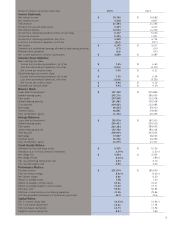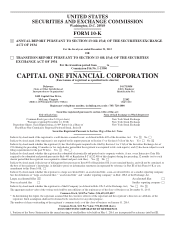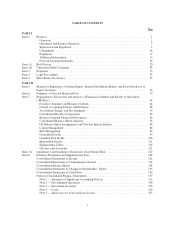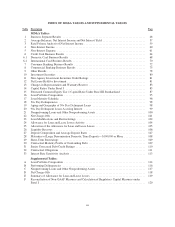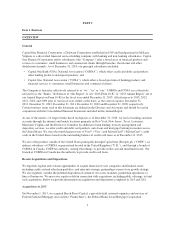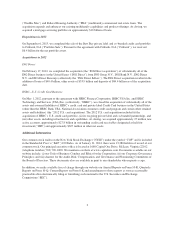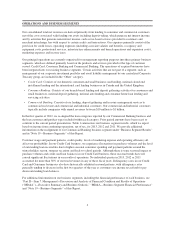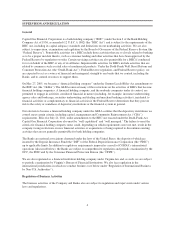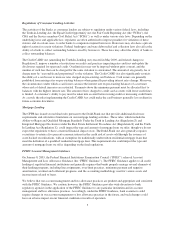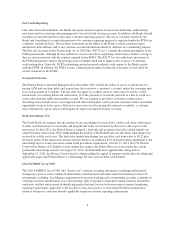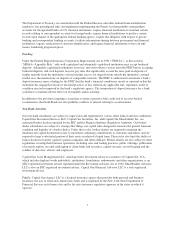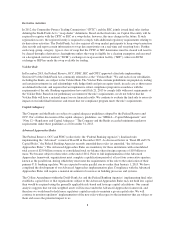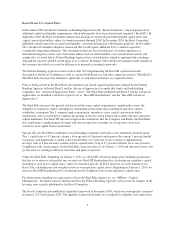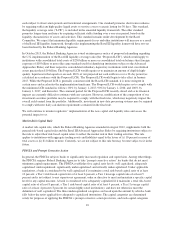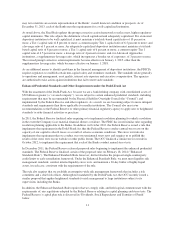Capital One 2013 Annual Report Download - page 25
Download and view the complete annual report
Please find page 25 of the 2013 Capital One annual report below. You can navigate through the pages in the report by either clicking on the pages listed below, or by using the keyword search tool below to find specific information within the annual report.Regulations of Consumer Lending Activities
The activities of the Banks as consumer lenders are subject to regulation under various federal laws, including
the Truth-in-Lending Act, the Equal Credit Opportunity Act, the Fair Credit Reporting Act (the “FCRA”), the
CRA and the Service members Civil Relief Act (“SCRA”), as well as under various state laws. Depending on the
underlying issue and applicable law, regulators are often authorized to impose penalties for violations of these
statutes and, in certain cases, to order banks to compensate injured borrowers. Borrowers may also have a private
right of action for certain violations. Federal bankruptcy and state debtor relief and collection laws also affect the
ability of a bank to collect outstanding balances owed by borrowers. These laws may affect the ability of banks to
collect outstanding balances.
The Credit CARD Act (amending the Truth-In-Lending Act) enacted in May 2009, and related changes to
Regulation Z, impose a number of restrictions on credit card practices impacting rates and fees and update the
disclosures required for open-end credit. Overlimit fees may not be imposed without prior consent, and the
number of such fees that can be charged for the same violation is constrained. The amount of any penalty fee or
charge must be “reasonable and proportional” to the violation. The Credit CARD Act also significantly restricts
the ability of a card issuer to increase rates charged on pre-existing card balances. Card issuers are generally
prohibited from raising rates on pre-existing balances when generally prevailing interest rates change. Moreover,
the circumstances under which a card issuer can raise the interest rate on pre-existing balances of a customer
whose risk of default increases are restricted. Payments above the minimum payment must be allocated first to
balances with the highest interest rate. The amount of fees charged to credit card accounts with lower credit lines
is limited. A consumer’s ability to pay must be taken into account before issuing credit or increasing credit limits.
As a result, the rules implementing the Credit CARD Act could make the card business generally less resilient in
future economic downturns.
Mortgage Lending
The CFPB has issued several final rules pursuant to the Dodd-Frank Act that provide additional disclosure
requirements and substantive limitations on our mortgage lending activities. These rules, which include the
Ability-to-Repay and Qualified Mortgage Standards Under the Truth in Lending Act (Regulation Z) and
Integrated Mortgage Disclosures under the Real Estate Settlement Procedures Act (Regulation X) and the Truth
In Lending Act (Regulation Z), could impact the type and amount of mortgage loans we offer, though we do not
expect the regulations to have a material financial impact on us. The Dodd-Frank Act also generally requires
securitizers to retain a five percent economic interest in the credit risk of assets sold through the issuance of
asset-backed securitizations, with an exemption for traditionally underwritten residential mortgage loans that
meet the definition of a qualified residential mortgage loan. This requirement also could impact the type and
amount of mortgage loans we offer, depending on the final regulations.
FFIEC Account Management Guidance
On January 8, 2003, the Federal Financial Institutions Examination Council (“FFIEC”) released Account
Management and Loss Allowance Guidance (the “FFIEC Guidance”). The FFIEC Guidance applies to all credit
lending of regulated financial institutions and generally requires that banks properly manage several elements of
their lending programs, including line assignments, over-limit practices, minimum payment and negative
amortization, workout and settlement programs, and the accounting methodology used for various assets and
income items related to loans.
We believe that our account management and loss allowance practices are prudent and appropriate and consistent
with the FFIEC Guidance. We caution, however, the FFIEC Guidance provides wide discretion to bank
regulatory agencies in the application of the FFIEC Guidance to any particular institution and its account
management and loss allowance practices. Accordingly, under the FFIEC Guidance, bank examiners could
require changes in our account management or loss allowance practices in the future, and such changes could
have an adverse impact on our financial condition or results of operation.
5


